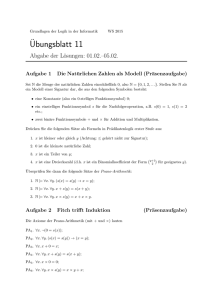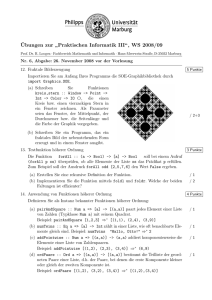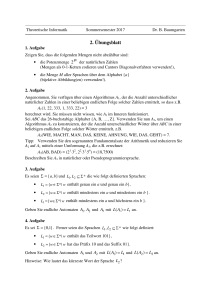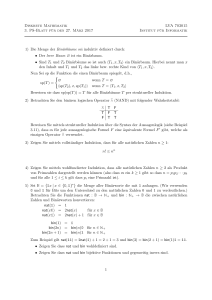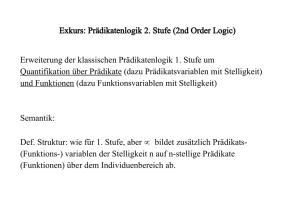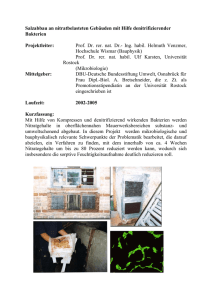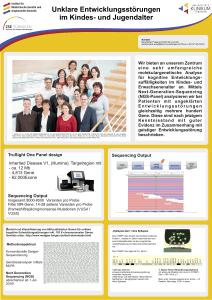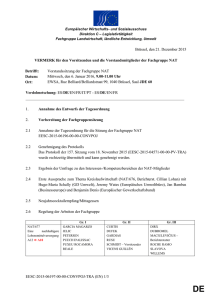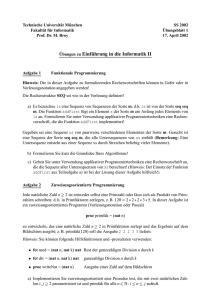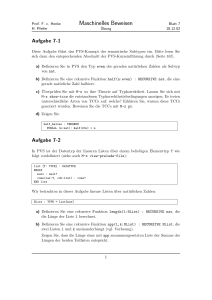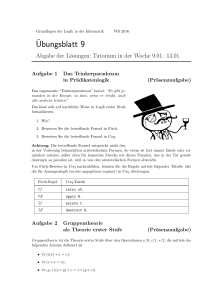Übungen zu "Grundlagen der Logik in der Informatik" - WS15/16
Werbung
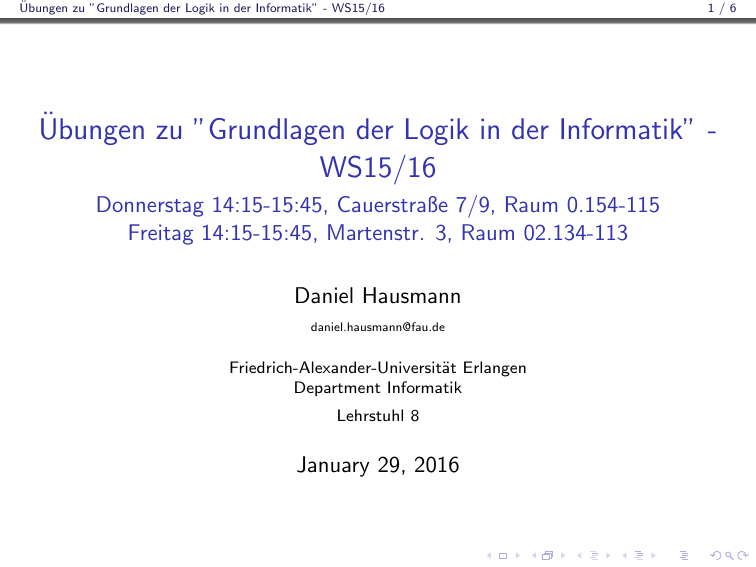
Übungen zu ”Grundlagen der Logik in der Informatik” - WS15/16 1/6 Übungen zu ”Grundlagen der Logik in der Informatik” WS15/16 Donnerstag 14:15-15:45, Cauerstraße 7/9, Raum 0.154-115 Freitag 14:15-15:45, Martenstr. 3, Raum 02.134-113 Daniel Hausmann [email protected] Friedrich-Alexander-Universität Erlangen Department Informatik Lehrstuhl 8 January 29, 2016 Übungen zu ”Grundlagen der Logik in der Informatik” - WS15/16 | Wiederholung | Wiederholung aus der Vorlesung Prädikatenlogische Modelle Sei Σ eine Signatur und V eine Menge von Variablen. Σ-Modell Ein Σ-Modell M besteht aus einer Menge M (Universum, (Grund)bereich oder Träger); einer Interpretation in M für jedes n-stellige Funktionssymbol f /n ∈ Σ, gegeben durch eine Funktion M[[f ]] : M n → M einer Interpretation in M für jedes n-stellige Prädikatensymbol P/n ∈ Σ, gegeben durch eine Teilmenge M[[P]] ⊆ M n . Eine Umgebung η (in M) ist eine Abbildung η : V → M. 2/6 Übungen zu ”Grundlagen der Logik in der Informatik” - WS15/16 | Wiederholung | Wiederholung aus der Vorlesung Prädikatenlogische Modelle Interpretation von Termen, Erfülltheit Die Interpretation M[[E ]]η ∈ M eines Terms E ist rekursiv definiert: M[[x]]η = η(x) M[[f (E1 , . . . , En )]]η = M[[f ]] (M[[E1 ]]η, . . . , M[[En ]]η) Die Erfülltheit einer Formel ϕ ist rekursiv definiert: M, η |= (E = D) ⇐⇒ M[[E ]]η = M[[D]]η M, η |= P(E1 , . . . , En ) ⇐⇒ (M[[E1 ]]η, . . . , M[[En ]]η) ∈ M[[P]] M, η |= ∀x.ϕ ⇐⇒ für alle m ∈ M gilt M, η[x 7→ m] |= ϕ und durch die erwarteten Klauseln ( für die booleschen Fälle, wobei m (y = x) η[x 7→ m](y ) = η(y ) (sonst). 3/6 Übungen zu ”Grundlagen der Logik in der Informatik” - WS15/16 | Übungsblatt 11 | Aufgabe 1 (Präsenzaufgabe) 4/6 Aufgabe 1 - Die Natürlichen Zahlen als Modell Sei N = {0, 1, 2, . . .}. Stellen Sie N als ein Modell der Signatur Σ = (∅, {0/0, s/1, +/2, ×/2}) dar. Drücken Sie die folgenden Sätze als Formeln in Prädikatenlogik erster Stufe aus: 1 x ist kleiner oder gleich y (Achtung: ≤ gehört nicht zur Signatur) 2 0 ist die kleinste natürliche Zahl 3 x ist ein Teiler von y 4 x isteine Dreieckszahl (d.h. x ist ein Binomialkoeffizient der Form y +1 für geeignetes y ) 2 Überprüfen Sie dann die folgende Sätze der Peano-Arithmetik: 1 N |= ∀x. ∀y . (s(x) = s(y ) → x = y ) 2 N |= ∀x. ∀y . x + s(y ) = s(x + y ) 3 N |= ∀x. ∀y . x × s(y ) = x + x × y Übungen zu ”Grundlagen der Logik in der Informatik” - WS15/16 | Übungsblatt 11 | Aufgabe 2 (Präsenzaufgabe) Aufgabe 2 - Fitch trifft Induktion Die Axiome der Peano-Arithmetik (mit + und ×) lauten PA1 . ∀x. ¬(0 = s(x)) PA2 . ∀x. ∀y . (s(x) = s(y )) → (x = y ) PA3 . ∀x. x + 0 = x PA4 . ∀x. ∀y . x + s(y ) = s(x + y ) PA5 . ∀x. x × 0 = 0 PA6 . ∀x. ∀y . x × s(y ) = x × y + x PA7 . ∀y1 , . . . , yn . φ(0, y1 , . . . , yn ) ∧ ∀x. (φ(x, y1 , . . . , yn ) → φ(s(x), y1 , . . . , yn )) → ∀x. φ(x, y1 , . . . , yn ) PA7 ist ein Axiomenschema, das für jedes φ ein Axiom erzeugt, eine sogenannte Instanz. Diese Instanzen heißen erwartungsgemäß Induktionsaxiome. 5/6 Übungen zu ”Grundlagen der Logik in der Informatik” - WS15/16 | Übungsblatt 11 | Aufgabe 2 (Präsenzaufgabe) Aufgabe 2 - Fitch trifft Induktion Beweisen Sie die folgende Modifikation von PA3 in Fitch: PA03 . ∀x. 0 + x = x. Formalisieren Sie Ihren Fitch-Beweis in Coq. 1 Require Import Classical. 2 3 Parameter Nat: Set. (* Typ der natürlichen Zahlen *) 4 5 6 Parameters zero: Nat. Parameters s: Nat -> Nat. 7 8 Parameters plus times: Nat -> Nat -> Nat. 9 10 11 Notation "A + B" := (plus A B). Notation "A * B" := (times A B). (* Infixnotation für plus *) (* Infixnotation für times *) 12 13 Notation "0" := (zero). 14 15 16 17 18 19 20 21 Axiom Axiom Axiom Axiom Axiom Axiom Axiom 22 23 PA1: PA2: PA3: PA4: PA5: PA6: PA7: forall x: Nat, ~(0 = s(x)). forall x y: Nat, (s(x) = s(y)) -> (x=y). forall x: Nat, x + 0 = x. forall x y: Nat, x + s(y) = s(x+y). forall x: Nat, x * 0 = 0. forall x y, x * s(y) = x * y + x. forall P: Nat -> Nat -> Prop, forall y:Nat, P 0 y /\ forall x: Nat, (P x y -> P (s x) y) -> forall x, P x y. 24 25 Lemma PA3’: forall x:Nat, 0 + x = x. 26 27 (* Ihren Beweis hier einfügen *) 28 29 Qed. 6/6
